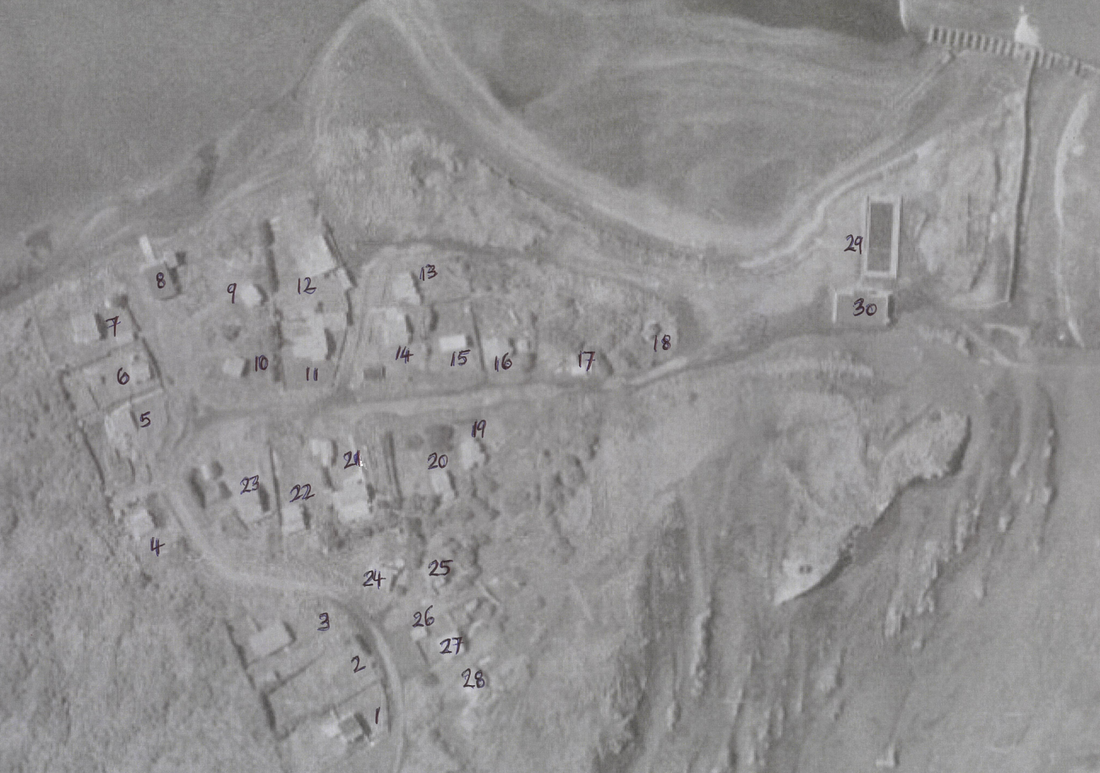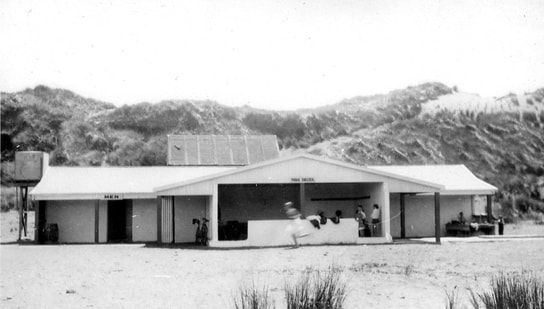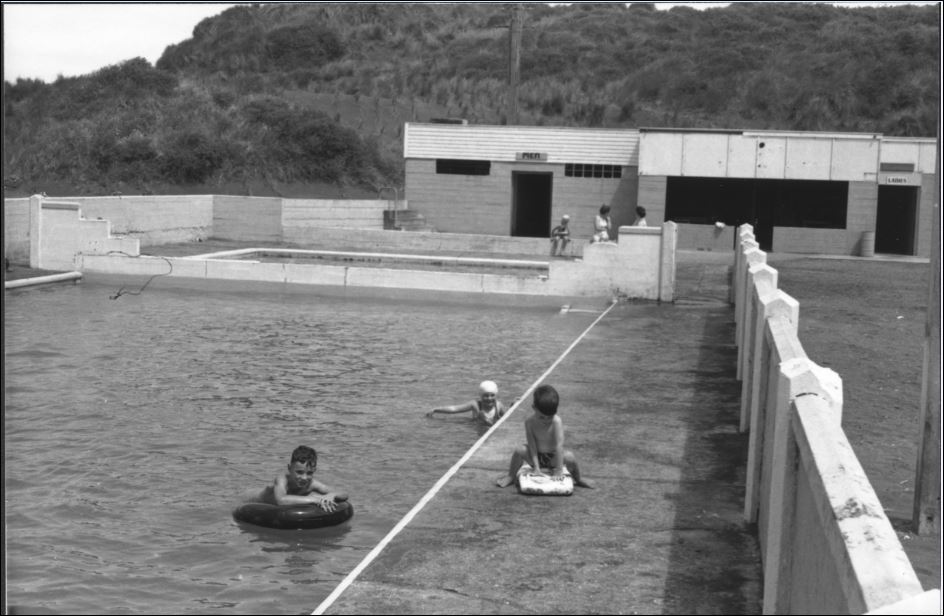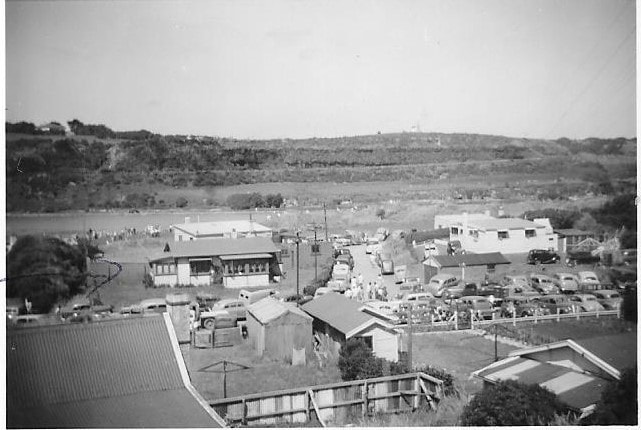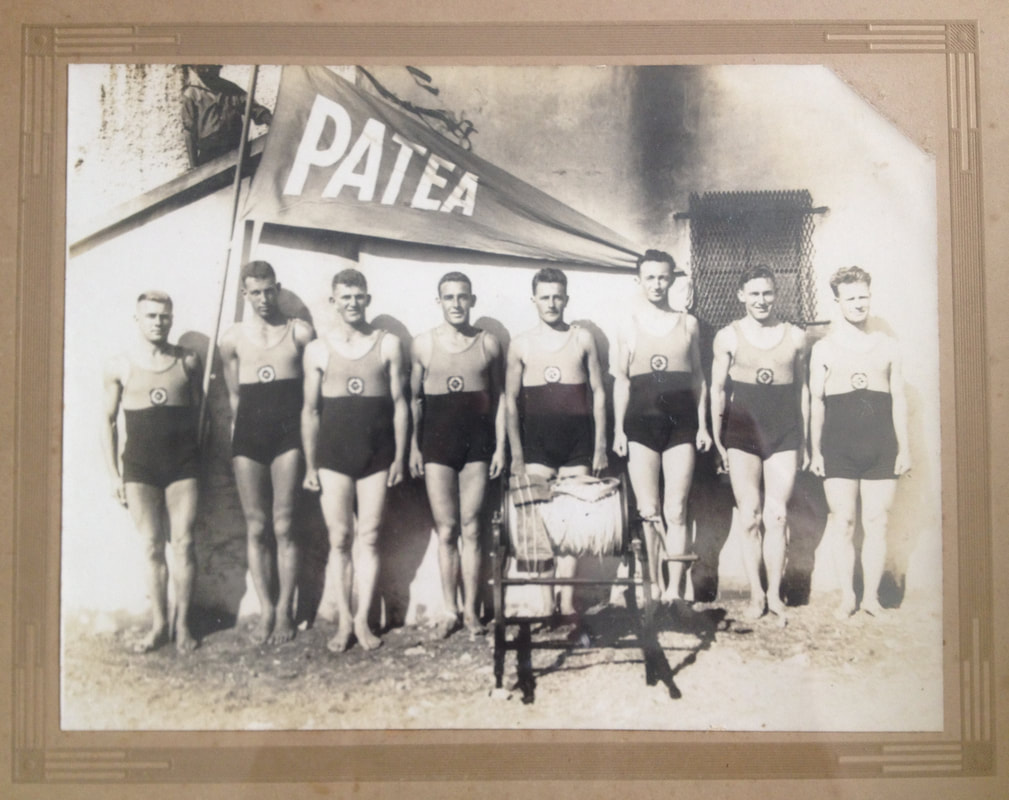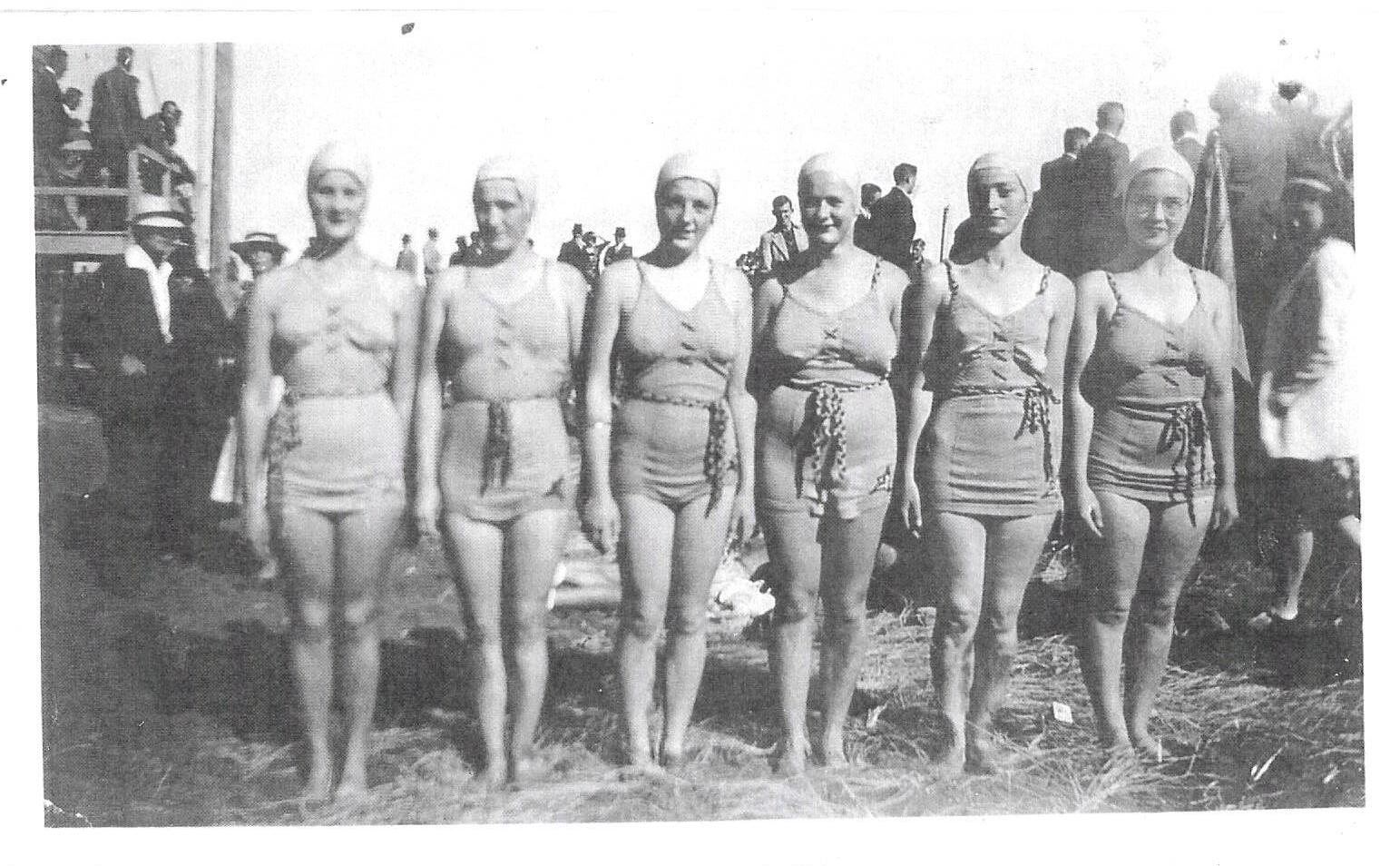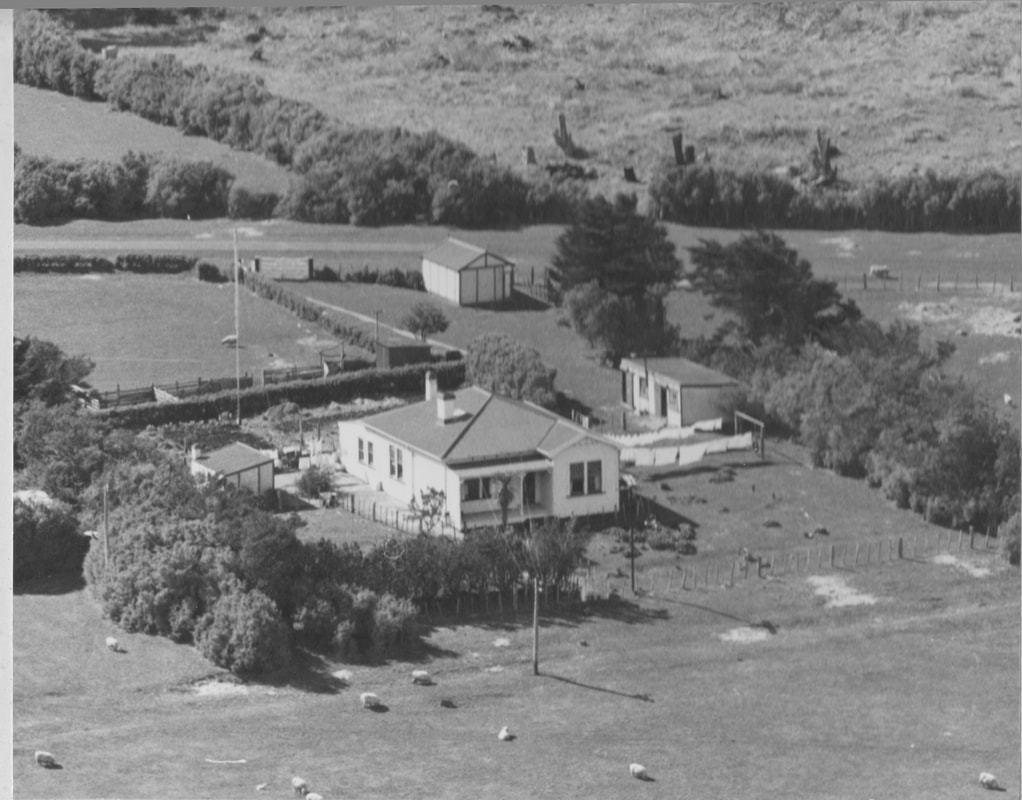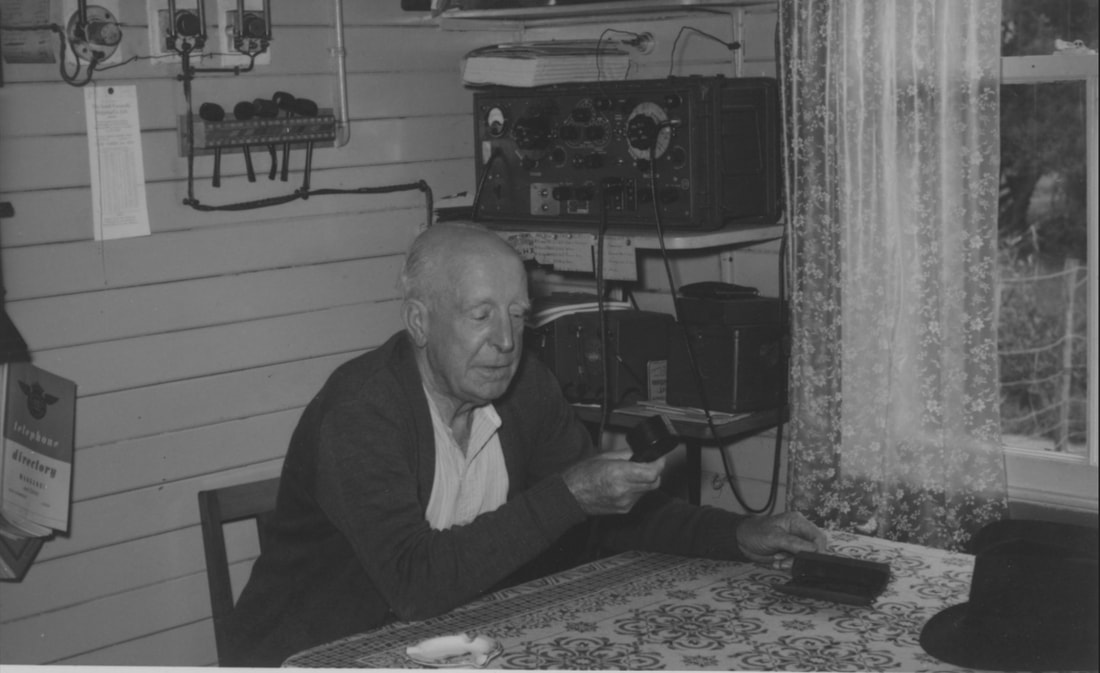The Patea Beach has seen many changes over the years. It was a military settlement & trading post in the 1860s. Then a busy exporting Port at the turn of the century. The first metalled road for vehicles down to the beach was laid in 1928 (tarseal came decades later), before that it had been a narrow track that changed as the sand drifted. Doug Roots, Lewis Adams, Fred Locker, James Fairweather, Mayor Finlayson, Mr TJC Scott were instrumental in its construction. In the summer of 1930 the Patea Seaside Improvement Society was formed, for the double purpose of maintenance & safety. The duties were separated with the amicable formation of the Patea Surf & Swimming Club soon after. The Society organised beach carnivals, picnics & boating regattas of various kinds, as fundraisers to finance improvements in the Beach Settlement. In 1938 a tea Kiosk was built with changing rooms on each side, & 1939 saw the completion of the Centennial Memorial (to commemorate the Treaty of Waitangi) (Salt water) Baths. The opening ceremony on Saturday 2 December 1939 was reported in the Patea Mail: ‘The work of constructing the memorial has boon carried out under the supervision of Mr H. J. Peacocke, who lives in the immediate vicinity, and who has taken the keenest interest in the work. He has been assisted by Mr. H. Boagey, the secretary, of the Seaside Improvement Society, Mr E. O. Horner,- Mr Mairs and others, who, have been particularly keen on beautifying the beach. Those who have not seen it for some months have been amazed at the strides that have been made. Large hills of sand have been levelled and a spacious, parking area formed, and its sides planted with ice-plants which are thriving apace and present a very pretty picture. 'The side of the large sandy beach, from near the point known as Pulley’s wharf, has been built up with concrete slabs sunk eight feet into the sand. These, which are covered with iceplants, will check any erosion in the future. The road to the bathing shed has been widened and levelled, and the bank here built up and planted with ice-plants. The large hill has a portion levelled off. and planted with ngaio trees, which will enable picnic parties to rest in shelter in the near future, for the trees are growing apace. The hill has also had paths formed from the roadway to the top, where people can have a glorious view of the harbour entrance and the Tasman Sea. The swimming bath and paddling pool are filled with sea water by means of a powerful pump driven by electricity, this work being carried out by the borough engineer, Mr J. O. Cunningham and his staff, who are to be complimented on the work, like the rest of those assisting in the construction of the memorial’
Soon after it was opened also saw a huge storm, with erosion & damage in the area near the Baths. With WWII in full swing, the repairs done were minimal, but the sand was cleared away, the roof rebuilt on the kiosk & beach fun continued. Bill Verney remembers two caves in the huge clay bank behind the Kiosk, it had table and chairs in it, so people could sit and eat in the shade on a hot day. The two caves were joined by an opening dug through the clay, so you could walk between the two. They were eventually covered over by sand, and no cave can now be seen, it is just a huge sandhill. A Queen Carnival was held in 1946 and £1350 was raised by the Patea Seaside Improvement Society. For any event like this a ‘slippery pole’ was suspended across the pool for the children to play on all day. By the mid 1950’s the Patea Borough Council had taken over responsibility of the Beach Settlement, & the Patea Seaside Improvement Society went into recess. There were many memorable events held at the beach from this time: Speedboat regattas, raft races from the rail bridge to the beach, bonfire nights where all the drift wood was piled up and people came from far and wide to sit round the fire as the sun set. The Baths were deemed unsafe & unhygienic by the Health Department in 1968 & were closed, & eventually demolished in 1973. The ‘Town Baths’ had been built on Stafford Street in 1958.
Soon after it was opened also saw a huge storm, with erosion & damage in the area near the Baths. With WWII in full swing, the repairs done were minimal, but the sand was cleared away, the roof rebuilt on the kiosk & beach fun continued. Bill Verney remembers two caves in the huge clay bank behind the Kiosk, it had table and chairs in it, so people could sit and eat in the shade on a hot day. The two caves were joined by an opening dug through the clay, so you could walk between the two. They were eventually covered over by sand, and no cave can now be seen, it is just a huge sandhill. A Queen Carnival was held in 1946 and £1350 was raised by the Patea Seaside Improvement Society. For any event like this a ‘slippery pole’ was suspended across the pool for the children to play on all day. By the mid 1950’s the Patea Borough Council had taken over responsibility of the Beach Settlement, & the Patea Seaside Improvement Society went into recess. There were many memorable events held at the beach from this time: Speedboat regattas, raft races from the rail bridge to the beach, bonfire nights where all the drift wood was piled up and people came from far and wide to sit round the fire as the sun set. The Baths were deemed unsafe & unhygienic by the Health Department in 1968 & were closed, & eventually demolished in 1973. The ‘Town Baths’ had been built on Stafford Street in 1958.
These are the families that lived at the Patea Beach settlement in the 1940s-80s,
Patea Beach ‘home owners’ Key
1. Monty Boagey/Bolstad
2. Louis & Isobel Budd
3. Weidenbolm/ Ralph & Iris Marsh/Skip & Ina Gallagher/Broughton
4. Willis Earp / Mills
5. Vose/Collett
6. Vern Jones (electrician)/Molly Waitokia (nee Nuku-Tarawhiti)
7. James and Charlotte (Lalie) Haworth/ Tom & Sis Reardon/Peter Van Megan/Tu Flavell/John & Shirley Matthews
8. Boat Shed/Carlyle Repertory Playhouse
9. Weherua/Bill Stewart
10. Darcy & Pam Gilmore-Featonby
11. Hillary & Edna Peacocke/Jack & Lillian Hunter/Bill Mischefski/Weherua
12. George Waterland/Tommy & Mahia Stephens/Bill Turner/Boat Club Rooms
13. Myrtle Griffiths/Kahu
14. Hugh & Noreen Cameron-Lee/Doug Jones/Billy Tipene/Patterson
15. Monica Harris/ Ron & Ann Roach
16. Alan & Jean Scobie/Piri Te Kamo & Te Hukinga Nuku-Tarawhiti
17. Unsure?
18. Beach Store-Mrs Lil Hunter/Doug & Eileen Ansley
19. Reverend Ray & Jean Patchett/ Bob & Mikee Adams
20. Lewis & Rose Adams
21. Bert & Edith Boagey (nee Adams)/Rangi & Edith Abraham
22. Pilcher/Leet/John & Sherie Crisp /Ken Bentley/Snow Parkinson
23. Bob Craig/Bill & Jess Law/ John & Sue Atkin
24. Cooper/Ian & Edith Carlyle/Des Partridge
25. Huia Pulley-Reid, rented by Vince & Ruby Froome
26. Faulkner/Vince & Ruby Froome/Norm & Ethel Railton
27. Fred Leach
28. Paddy & Ethel Bourke-rented by Howard & Moana Herbert/Bookers?
29. Centennial Swimming Pool built 1940, commemoration of Treaty of Waitangi
30. Changing rooms and Kiosk for Pool
Noeline Kerrisk nee Griffiths, lived at the beach with her Mum, two sisters & a brother in the late 1930’s into the 1940’s and helped with names of people that lived at lived here at this time, as did Moira Cameron-Lee. A big storm in 1955 covered a lot of houses with sand. The home that Howard and Moana Herbert lived in, near what is now Bourke’s Look out, was buried in a sand drift. Part of this house was left behind under the sand, but the main part of the house was moved up to town (it has since burnt down) Contrary to popular belief, the homes that were partially buried, were dug out again, and 2 or 3 of them were moved up into the township, away from the moving sand. Huia Pully-Reid’s home was moved to the corner of Kent and Essex Street. Clive Robinson extended and restored it and ran it as a Dairy, from 1961-1968 (perfect position opposite the High School). It was then bought by Cedric & Elaine Christiansen. Clive said there was a lot of sand in the walls when he did renovations, confirming its near burial in the 1955 storm. Fred Leach’s home was moved from the Beach to 1 Kent Street, and two of the Adams family baches were moved to 6 Kent Street, joined together and became the home of Ike and Sylvia Ansley.
The first section of road heading down the hill to the first corner was moved about 10m to the left after the storm had moved tons of sand on to this hill. The Budd’s home at the top of the incline, was burnt down in the 1940’s, one of their children died in the fire. And Monty Boagy’s home, first on the left going down the hill, is long gone. The road beyond where the boat ramp is now looped round behind the Griffiths home, so there was always two ways to get into the beach if one way was covered with sand. Hugh Campbell was always digging out sand drifts to keep the road open. He was a contractor, and the beach was his domain to keep clear of sand buildup.
Willis Earp was a returned WWI man, he lived in a small bach by what is now the entrance to Campground. He was fondly known as Earpy. He later became the caretaker and the Domain and moved to a small dwelling near the Domain.
Noeline remembers Mr & Mrs Vose had a lovely garden down on the corner of Turi St. The large old Boat Club building was alongside Turi St, towards the end. It housed canoes, skiffs, & other rowing equipment for the young people to use on the river back then. This building was later used by the Patea Players, for their theatrical productions (they also used the Mineral Factory on Victoria Street for rehearsal’s). The road continued toward the river & looped round again down near the Baths, drivers always kept left, & this loop was one way traffic. Monica Harris’s old house was pulled down when she left, & Ron Roach moved the ‘single men’s quarters’ from the Kakaramea Dairy factory on in the late 1970’s, & with the help of his son, Lewis turned it into a family home. Lewis told me how his father rang his teacher at Patea High School & told them he would be away from School for a week. Being the local Cop, he could do this without issue! When Alan & Jean Scobie’s house was pulled down, it was found to have a ‘lockup cell door’ in the centre of it. It is thought that it was from the times of the first military settlement on the beach in 1860s. Brett Lowe is the Grandson of Mr Marsh the milkman. He told me that Ralph Marsh moved to NZ from England in 1947 and was followed by Brett’s Uncle (Barrie) and Grandmother (Iris) the next year. His mother (Catherine) was born in Patea in 1949. They moved away in 1955 or 56 to live in Lysaght's Homestead in Mokoia.
The mail was delivered by the Postman on a bicycle. Pop Gunn was mailman in the late 1940’s, then Michael Kerrisk, then Neville Telfer. Hugh Cameron-Lee was the first person to run the Camp Ground, then Doug Jones, then ?, then Ken Bentley, now Heni & Glenys Van Dedenter.
Tom and Sis Reardon lived in the house at the end of Turi Street on the left by the boat ramp, with Jim Haworth when he was widowed. Jim & Lalie Haworth were part owners of the large two storey ‘Haworth & Harris’ Store at the top of Bedford Street. Bourkes Lookout was formed in the early 1970’s, named after Kevin Bourke, he was on the Patea Council and his aunt and uncle Paddy and Ethel Bourke, had a bach below it. Their home was covered with sand in the 1955 storm. Hughie Campbell salvaged what he could of it and built a home for him and his wife Beth and family on the corner of Leicester and Stafford Street. This home later burnt down and they moved to Hawera.
Mrs Hunter had a small shop that opened most days in the summer months on the grass area at the end of the loop road, later run by Doug and Eileen Ansley. Fred Leach, or Skinny as he was known, would always be waiting at the top of the hill on a Friday & Saturday night, to meet the bus coming back from dances, & walk back with the young people to make sure they got home ok. It was a caring community, where everyone looked out for each other. The saltwater Swimming Pools were a popular spot all summer long at the Beach.
Patea Beach ‘home owners’ Key
1. Monty Boagey/Bolstad
2. Louis & Isobel Budd
3. Weidenbolm/ Ralph & Iris Marsh/Skip & Ina Gallagher/Broughton
4. Willis Earp / Mills
5. Vose/Collett
6. Vern Jones (electrician)/Molly Waitokia (nee Nuku-Tarawhiti)
7. James and Charlotte (Lalie) Haworth/ Tom & Sis Reardon/Peter Van Megan/Tu Flavell/John & Shirley Matthews
8. Boat Shed/Carlyle Repertory Playhouse
9. Weherua/Bill Stewart
10. Darcy & Pam Gilmore-Featonby
11. Hillary & Edna Peacocke/Jack & Lillian Hunter/Bill Mischefski/Weherua
12. George Waterland/Tommy & Mahia Stephens/Bill Turner/Boat Club Rooms
13. Myrtle Griffiths/Kahu
14. Hugh & Noreen Cameron-Lee/Doug Jones/Billy Tipene/Patterson
15. Monica Harris/ Ron & Ann Roach
16. Alan & Jean Scobie/Piri Te Kamo & Te Hukinga Nuku-Tarawhiti
17. Unsure?
18. Beach Store-Mrs Lil Hunter/Doug & Eileen Ansley
19. Reverend Ray & Jean Patchett/ Bob & Mikee Adams
20. Lewis & Rose Adams
21. Bert & Edith Boagey (nee Adams)/Rangi & Edith Abraham
22. Pilcher/Leet/John & Sherie Crisp /Ken Bentley/Snow Parkinson
23. Bob Craig/Bill & Jess Law/ John & Sue Atkin
24. Cooper/Ian & Edith Carlyle/Des Partridge
25. Huia Pulley-Reid, rented by Vince & Ruby Froome
26. Faulkner/Vince & Ruby Froome/Norm & Ethel Railton
27. Fred Leach
28. Paddy & Ethel Bourke-rented by Howard & Moana Herbert/Bookers?
29. Centennial Swimming Pool built 1940, commemoration of Treaty of Waitangi
30. Changing rooms and Kiosk for Pool
Noeline Kerrisk nee Griffiths, lived at the beach with her Mum, two sisters & a brother in the late 1930’s into the 1940’s and helped with names of people that lived at lived here at this time, as did Moira Cameron-Lee. A big storm in 1955 covered a lot of houses with sand. The home that Howard and Moana Herbert lived in, near what is now Bourke’s Look out, was buried in a sand drift. Part of this house was left behind under the sand, but the main part of the house was moved up to town (it has since burnt down) Contrary to popular belief, the homes that were partially buried, were dug out again, and 2 or 3 of them were moved up into the township, away from the moving sand. Huia Pully-Reid’s home was moved to the corner of Kent and Essex Street. Clive Robinson extended and restored it and ran it as a Dairy, from 1961-1968 (perfect position opposite the High School). It was then bought by Cedric & Elaine Christiansen. Clive said there was a lot of sand in the walls when he did renovations, confirming its near burial in the 1955 storm. Fred Leach’s home was moved from the Beach to 1 Kent Street, and two of the Adams family baches were moved to 6 Kent Street, joined together and became the home of Ike and Sylvia Ansley.
The first section of road heading down the hill to the first corner was moved about 10m to the left after the storm had moved tons of sand on to this hill. The Budd’s home at the top of the incline, was burnt down in the 1940’s, one of their children died in the fire. And Monty Boagy’s home, first on the left going down the hill, is long gone. The road beyond where the boat ramp is now looped round behind the Griffiths home, so there was always two ways to get into the beach if one way was covered with sand. Hugh Campbell was always digging out sand drifts to keep the road open. He was a contractor, and the beach was his domain to keep clear of sand buildup.
Willis Earp was a returned WWI man, he lived in a small bach by what is now the entrance to Campground. He was fondly known as Earpy. He later became the caretaker and the Domain and moved to a small dwelling near the Domain.
Noeline remembers Mr & Mrs Vose had a lovely garden down on the corner of Turi St. The large old Boat Club building was alongside Turi St, towards the end. It housed canoes, skiffs, & other rowing equipment for the young people to use on the river back then. This building was later used by the Patea Players, for their theatrical productions (they also used the Mineral Factory on Victoria Street for rehearsal’s). The road continued toward the river & looped round again down near the Baths, drivers always kept left, & this loop was one way traffic. Monica Harris’s old house was pulled down when she left, & Ron Roach moved the ‘single men’s quarters’ from the Kakaramea Dairy factory on in the late 1970’s, & with the help of his son, Lewis turned it into a family home. Lewis told me how his father rang his teacher at Patea High School & told them he would be away from School for a week. Being the local Cop, he could do this without issue! When Alan & Jean Scobie’s house was pulled down, it was found to have a ‘lockup cell door’ in the centre of it. It is thought that it was from the times of the first military settlement on the beach in 1860s. Brett Lowe is the Grandson of Mr Marsh the milkman. He told me that Ralph Marsh moved to NZ from England in 1947 and was followed by Brett’s Uncle (Barrie) and Grandmother (Iris) the next year. His mother (Catherine) was born in Patea in 1949. They moved away in 1955 or 56 to live in Lysaght's Homestead in Mokoia.
The mail was delivered by the Postman on a bicycle. Pop Gunn was mailman in the late 1940’s, then Michael Kerrisk, then Neville Telfer. Hugh Cameron-Lee was the first person to run the Camp Ground, then Doug Jones, then ?, then Ken Bentley, now Heni & Glenys Van Dedenter.
Tom and Sis Reardon lived in the house at the end of Turi Street on the left by the boat ramp, with Jim Haworth when he was widowed. Jim & Lalie Haworth were part owners of the large two storey ‘Haworth & Harris’ Store at the top of Bedford Street. Bourkes Lookout was formed in the early 1970’s, named after Kevin Bourke, he was on the Patea Council and his aunt and uncle Paddy and Ethel Bourke, had a bach below it. Their home was covered with sand in the 1955 storm. Hughie Campbell salvaged what he could of it and built a home for him and his wife Beth and family on the corner of Leicester and Stafford Street. This home later burnt down and they moved to Hawera.
Mrs Hunter had a small shop that opened most days in the summer months on the grass area at the end of the loop road, later run by Doug and Eileen Ansley. Fred Leach, or Skinny as he was known, would always be waiting at the top of the hill on a Friday & Saturday night, to meet the bus coming back from dances, & walk back with the young people to make sure they got home ok. It was a caring community, where everyone looked out for each other. The saltwater Swimming Pools were a popular spot all summer long at the Beach.
.
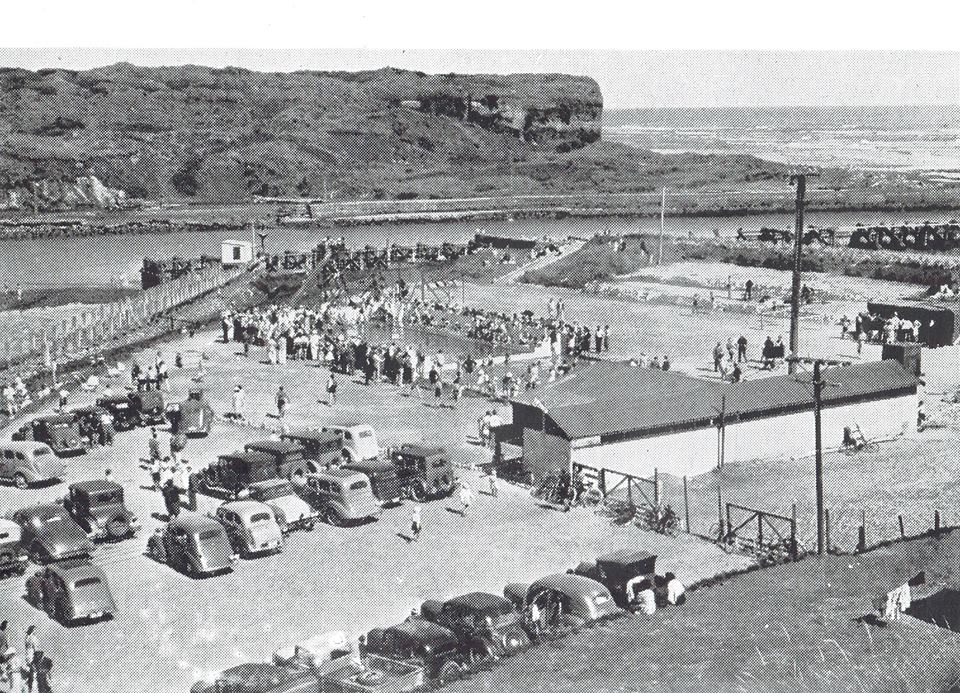
I remember these bathes and to the right of this photo there was a flat clay area and cliffs in the cliffs were 2 caves with seats in them and we used to sit in out of the sun to have a picnic lunch but alas the sand took that before it took half the homes on the way to the beach. On the left you can see the pump house sitting on the wooden breakwater (this was later shifted further to the right. Us boys used to dive in off the end of this at full tide and swim with the wave and climb back up behind the wall for if you came back to the corner you could get caught in the back wash and swept out or climb further along the breakwater if you could swim to it , I remember pulling one boy to the breakwater But it didn't deter us. When we were older about the 1950's we used to go down to the bathes to help old Hughie Cameron Lee clean out the sand etc when the bath was emptied for in later years there was always a lot of sand and Hughie was getting on so it was a good way to payback for a facility that gave us guys a great place to spend our youth. Memories from Bill Verney.
Looking towards the Railway line behind the River. Jack & Lilian's Hunter's house to the left/middle. Behind it is Mr & Mrs Waterlands. Behind all the parked cars on the right side, is Mr & Mrs Cameron-Lees house, & just behind that is Mrs Griffiths house. The Pools are just out of the picture in the front right. Thkyou Hazel Morey (nee Bates) for this photo
The first Patea Surf Club formed in the early 1930s Left to Right: Ben Currie, D Grant, P Bourke, R (Bob) Adams, Alic Gillon, G Fraser, B Edwards, R James. This photo is from Ashleigh Gillon, the son of Alic Gillon (Alic was married to Bob Adam's sister Lila). Alic was killed in WWII. Fred Verney formed one of the very first woman’s surf teams in Patea due to the fact most of the men were overseas fighting for our freedom. the names Ashleigh remembers are Betty Mills (later Mrs Kasper whose husband Jack had an epileptic fit while fishing on the southern wall at the river mouth and drowned)Betty Turner, Helen Hamerton, cannot think of the other at least three names.
Patea Women's Surf Life Saving Team 1938, Miss Anderson, Helen Somerville, Bai Illingworth, Jean Quickenden, Bub Willis, Nola Freeman
This is the Harbour Master's house in about 1955, over the river on the Whenuakura side.
Harbour Masters:
Alfred Wood- 1871-1882
John Flowerday- 1882-1904
Martin Henry Frederick Petersen- 1904-1906
William Tinney- 1906-1930
William Edward Barnes - 1930 -1955
John Shirley Dracap- 1955-1959.
This house was built by Mr Alistair Gunn & Co in 1912, it is still there, although much altered now, with a second storey added.
This photo was taken when Harbour Master John S Dracup lived there. His daughter Eleanor Bensemann has written a book about her Dads' life in shipping around NZ: 'John S Dracup, The life & times of a seafaring man'. There is an interesting chapter about his time in Patea. This photo was taken in about 1955 when John & Elsie Bensmann & their 5 children lived there. Their twin girls, Winsome & Wendy had just been born & the clothes line is full of nappies. Thank you Eleanor Bensemann for this great photo.
Harbour Masters:
Alfred Wood- 1871-1882
John Flowerday- 1882-1904
Martin Henry Frederick Petersen- 1904-1906
William Tinney- 1906-1930
William Edward Barnes - 1930 -1955
John Shirley Dracap- 1955-1959.
This house was built by Mr Alistair Gunn & Co in 1912, it is still there, although much altered now, with a second storey added.
This photo was taken when Harbour Master John S Dracup lived there. His daughter Eleanor Bensemann has written a book about her Dads' life in shipping around NZ: 'John S Dracup, The life & times of a seafaring man'. There is an interesting chapter about his time in Patea. This photo was taken in about 1955 when John & Elsie Bensmann & their 5 children lived there. Their twin girls, Winsome & Wendy had just been born & the clothes line is full of nappies. Thank you Eleanor Bensemann for this great photo.
Captain W E Barnes on the radio to a ship coming into Patea. He was 72 when he retired and John Dracup took over the position, he had been Dredge Master up until then from 1949...waiting for the Harbour Master job to come available. William Edward Barnes, Pilot Station, Patea, harbour master 1930 - 1955 He was married to Clara Maude Barnes (this appears to also be her maiden name). Married 1911 probably in Auckland and they had two daughters Esme and Thelma.
Esme Mary b. 24 May 1912 – d. 4 July 2012
Thelma Francis. B. 18 May 1914 – d. 24 May 1988
Capt Barnes died 8 July 1956 in Wellington aged 72.
Photo from the Harry Baker Collection.
Esme Mary b. 24 May 1912 – d. 4 July 2012
Thelma Francis. B. 18 May 1914 – d. 24 May 1988
Capt Barnes died 8 July 1956 in Wellington aged 72.
Photo from the Harry Baker Collection.
